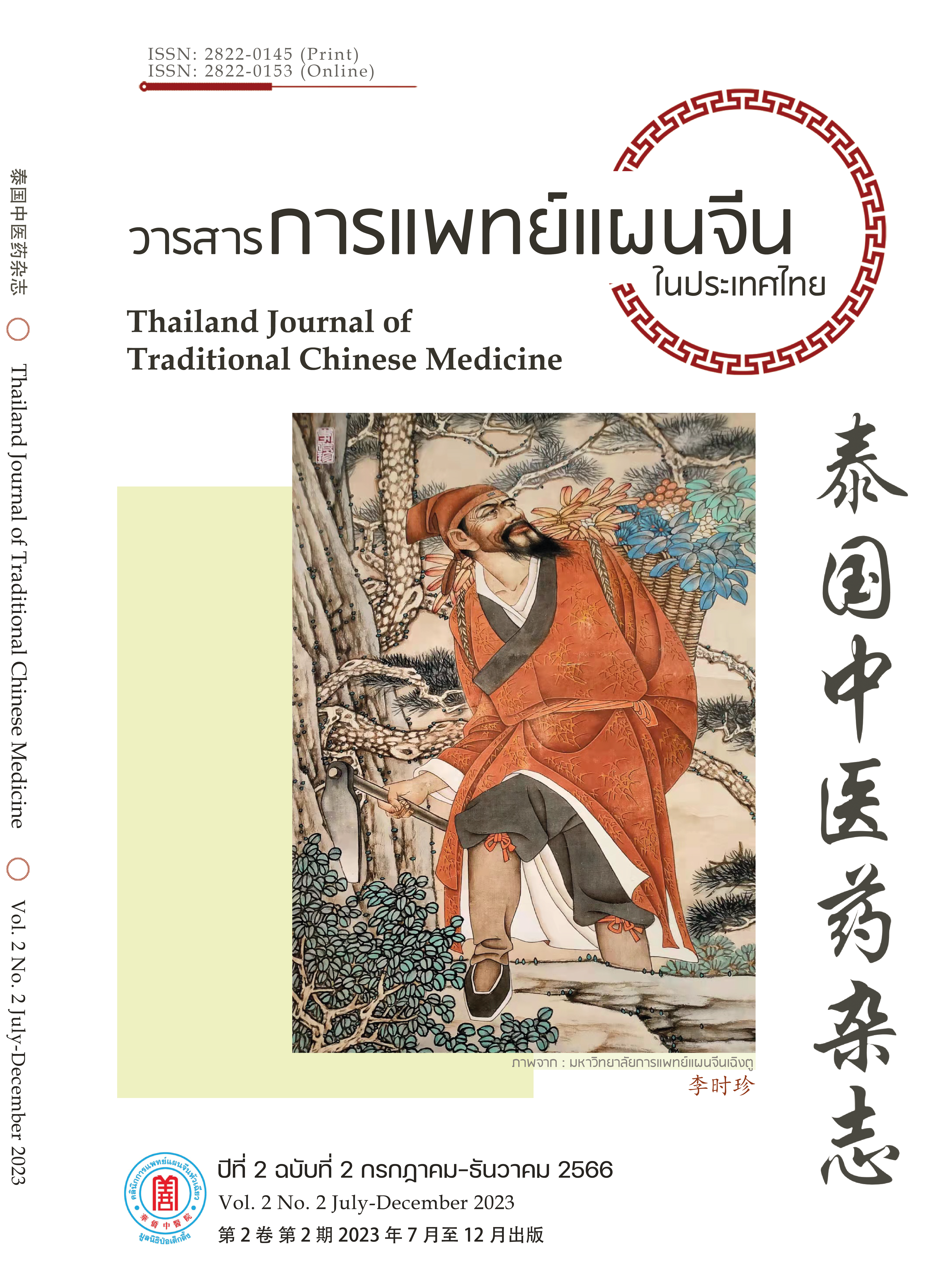การวิเคราะห์ความสัมพันธ์ของโรคระดับเลือด และระดับน้ำ ในคัมภีร์จินคุ่ยเอี้ยวเลี่ยต่อโรคกลุ่มอาการถุงน้ำรังไข่หลายใบ
Main Article Content
บทคัดย่อ
คัมภีร์จินคุ่ยเอี้ยวเลี่ยเป็นคัมภีร์สำคัญยิ่งในวงการแพทย์แผนจีนด้านนรีเวช ได้บันทึกรวบรวมความรู้และประสบการณ์ในการรักษาโรคทางนรีเวชมาอย่างยาวนาน แบ่งแยกประเภทของโรคและแนวทางการรักษาอย่างละเอียด เปรียบเสมือนรากฐานสำคัญในการพัฒนาการแพทย์แผนจีนด้านนรีเวช แม้จะผ่านกาลเวลามาหลายพันปี คัมภีร์จินคุ่ยเอี้ยวเลี่ยก็ยังทรงคุณค่าต่อการศึกษาและนำไปประยุกต์ใช้ บทความนี้ได้วิเคราะห์เรื่องโรคระดับเลือด และระดับน้ำ ที่ถูกบันทึกในคัมภีร์ รวมไปถึงความสัมพันธ์กับการเกิดโรคและแนวทางการรักษาโรคกลุ่มอาการถุงน้ำรังไข่หลายใบ (polycystic ovary syndrome, PCOS) จากการวิเคราะห์พบว่า คัมภีร์จินคุ่ยเอี้ยวเลี่ยไม่เพียงแต่สามารถกล่าวถึงกลไกการเกิดโรค PCOS ได้อย่างชัดเจน ทั้งยังระบุแนวทางการรักษาไว้อย่างครบถ้วน โดยมีงานวิจัยใหม่สนับสนุนหลักการนี้ ด้วยแนวทางการรักษานี้จะเกิดประโยชน์ต่อการปรับรอบประจำเดือน ลดภาวะดื้อต่ออินซูลิน สามารถนำไปประยุกต์ใช้เป็นแนวทางการรักษาโรค PCOS ในปัจจุบันต่อไป
Article Details
เอกสารอ้างอิง
Peterson KR, Link M, Peterson CM. Endocrine disorders. In: Berek JS, editor. Berek & Novak’s gynecology. 16th ed. Philadelphia: Wolters Kluwer; 2020. p. 2089-215.
Wang XJ, Qian YF, Zhang YH. Research progress on the treatment of polycystic ovary syndrome with traditional Chinese and Western medicine. Journal of Hebei Traditional Chinese Medicine and Pharmacology. 2009;24(1):47-8. (in Chinese)
Moran LJ, Norman RJ, Teede HJ. Metabolic risk in PCOS: phenotype and adiposity impact. Trends Endocrinol Metab. 2015;26(3):136-43.
Taylor HS, Pal L, Seli E. Speroff’s clinical gynecologic endocrinology and infertility. 9th ed. Philadelphia: Wolters Kluwer; 2020.
Du HY. The relationship between polycystic ovary syndrome and phlegm-damp constitution. Modern Traditional Chinese Medicine. 2007;(3):54-5. (in Chinese)
Li HH. The related research of phlegm physical and the characteristics of endocrine and metabolic with polycystic ovary syndrome (PCOS) [dissertation]. Henan: Henan College of Traditional Chinese Medicine; 2014. (in Chinese)
Zhang HY, Hou LH, Li Y. Study on the correlation between insulin resistance and TCM constitution in patients with polycystic ovary syndrome. Modern Journal of Integrated Traditional Chinese and Western Medicine. 2019;28(26):2851-4. (in Chinese)
Chen YX, Yang DZ, Li L, Chen XL, Li Y. Diagnostic value of ovarian morphology by ultrasonography in pubertal polycystic ovary syndrome. Chinese Journal of Obstetrics and Gynecology. 2007;42(9):586-9. (in Chinese)
Villa P, Rossodivita A, Sagnella F, Moruzzi MC, Mariano N, Lassandro AP, et al. Ovarian volume and gluco-insulinaemic markers in the diagnosis of PCOS during adolescence. Clin Endocrinol (Oxf). 2013;78(2):285-90.
Bednarska S, Siejka A. The pathogenesis and treatment of polycystic ovary syndrome: What's new?. Adv Clin Exp Med. 2017;26(2):359-67.
Moini Jazani A, Nasimi Doost Azgomi H, Nasimi Doost Azgomi A, Nasimi Doost Azgomi R. A comprehensive review of clinical studies with herbal medicine on polycystic ovary syndrome (PCOS). Daru. 2019;27(2):863-77.
Clark AM, Thornley B, Tomlinson L, Galletley C, Norman RJ. Weight loss in obese infertile women results in improvement in reproductive outcome for all forms of fertility treatment. Hum Reprod. 1998;13(6):1502-5.
Moran L, Norman RJ. Understanding and managing disturbances in insulin metabolism and body weight in women with polycystic ovary syndrome. Best Pract Res Clin Obstet Gynaecol. 2004;18(5):719-36.
Hollmann M, Runnebaum B, Gerhard I. Effects of weight loss on the hormonal profile in obese, infertile women. Hum Reprod. 1996;11(9):1884-91.
Dong J, Wang Q, Wang DP, Wu HD. Analysis of metabolic syndrome from the perspective of phlegm-damp constitution. Journal of Beijing University of Traditional Chinese Medicine. 2006;29(12):802-3. (in Chinese)
Gong WJ, Mi YJ, Shi YF. The effect of modified Erchen decoction on reproductive endocrine functions and glucose metabolism in patients with phlegm-dampness polycystic ovary syndrome complicated with insulin resistance. Int J Clin Exp Med. 2020;13(8):5932-40.
Chen JM, Zhang F, Deng J, Wang WB, Chen QL, Yu J. Correlation between TCM constitution and polycystic ovary syndrome: a meta-analysis. Chinese Journal of General Practice. 2022;20(4):691-5. (in Chinese)
Xu YZ, Zhang JY. Clinical observation of “Yishen Huatan Decoction” in treating polycystic ovary syndrome. Shanghai Journal of Traditional Chinese Medicine. 2008;49(9):34-5. (in Chinese)
Wang YP, Shun HF. Clinical observation on the treatment of 33 cases of adolescent polycystic ovarian syndrome with the kidney-tonifying, phlegm-activating and blood-activating method. Chinese Journal of Information on Traditional Chinese Medicine. 2008;15(2):66-7. (in Chinese)
Xiang S, Xia MF, Song JY, Liu DQ, Fang L. Effect of electro-acupuncture on expression of IRS-1/PI3K/GLUT4 pathway in ovarian granulosa cells of infertile patients with polycystic ovary syndrome-insulin resistance of phlegm-dampness syndrome. Chin J Integr Med. 2021;27(5):330-5.
Liang C, Cong J, Chang H, Kuang HY, Hou LH, Wu XK. Controlling effect of Bushen Huatan compound on the insulin signal conducting molecule inside ovaries in polycystic ovary syndrome model rats. Chinese Journal of Integrated Traditional and Western Medicine. 2011;31(12):1639-44. (in Chinese)
Hong YL, Wu F. Effect of Bushen Huatan recipe on the Akt signal pathway in polycystic ovarian syndrome model rats with insulin resistance: an experimental research. Chinese Journal of Integrated Traditional and Western Medicine. 2014;34(2):230-4. (in Chinese)


